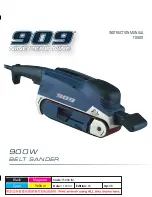
tool or a key left in a rotating part of the
power tool may result in injuries.
e)
Avoid working with your body in an
unusual position. Ensure proper footing
and balance at all times.
This enables
better control of the power tool in
unexpected situations.
f)
Wear appropriate clothing. Do not wear
loose clothing or jewellery. Keep your
hair and clothing away from moving
parts.
Loose clothes, jewellery or long
hair can be caught in moving parts.
g)
If dust extraction and collection
units can be installed, they have to be
connected and used properly.
Use of dust
collector can reduce dust-related hazards.
4)
Power tool use and care
a)
Do not overload the power tool. Use
power tools that are intended for your
work.
The correct power tool will do the
job better and safer at the rate for which it
was designed.
b)
Do not use the power tool if the switch is
faulty.
A power tool which can no longer
be switched on and off is dangerous and
has to be repaired.
c)
Disconnect the plug from the socket
and/or remove the battery before
making any adjustments, changing
tool bits or accessories or putting the
power tool away.
Such preventive safety
measures reduce the risk of starting the
power tool accidentally.
d)
Store power tools out of the reach of
children when not in use. Do not allow
persons unfamiliar with the power tool
or these instructions, to operate the
power tool.
Power tools are dangerous in
the hands of inexperienced users.
e)
Maintain the power tools and tool bits
carefully. Ensure the moving parts are
functioning correctly and do not getting
stuck. Check if parts are broken or so
badly damaged that that the power
tool's functions are impaired. Get
damaged parts repaired before using the
power tool.
Many accidents are caused by
poorly maintained power tools.
f)
Keep cutting tools sharp and clean.
Properly maintained tools with sharp
cutting edges are less likely to get stuck
and are easier to control.
g)
Use your power tool, accessories and
bits etc. according to these instructions.
Consider your working environment and
the type of job you wish to do.
Using
power tools for applications other than
those intended can lead to dangerous
situations.
5)
Usage and handling the cordless power
tool
a)
Charge batteries only using chargers
recommended by the manufacturer.
Charging batteries in a charger intended
for other types of battery can result in fire.
b)
Use only batteries designed for use with
the power tool.
The use of other batteries
can lead to injury or fire.
c)
When not in use, keep the battery away
from staples, coins, keys, nails, screws
or other metal objects which could
bridge the contacts on the battery.
A
short circuit between the battery contacts
can lead to burns or fire.
d)
Fluid can leak from the battery if the
machine is used incorrectly. Avoid any
contact with any fluid which may leak
from the battery. Wash your skin with
water should the fluid come into contact
with your skin. Should the fluid come
into contact with your eyes, rinse with
water and seek medical attention.
Fluid leaking from batteries can lead to
irritation or burns.
6)
Service
a)
Have your power tool repaired only
by qualified personnel and only with
original spare parts.
This will ensure that
the safety of the power tool is maintained.


































